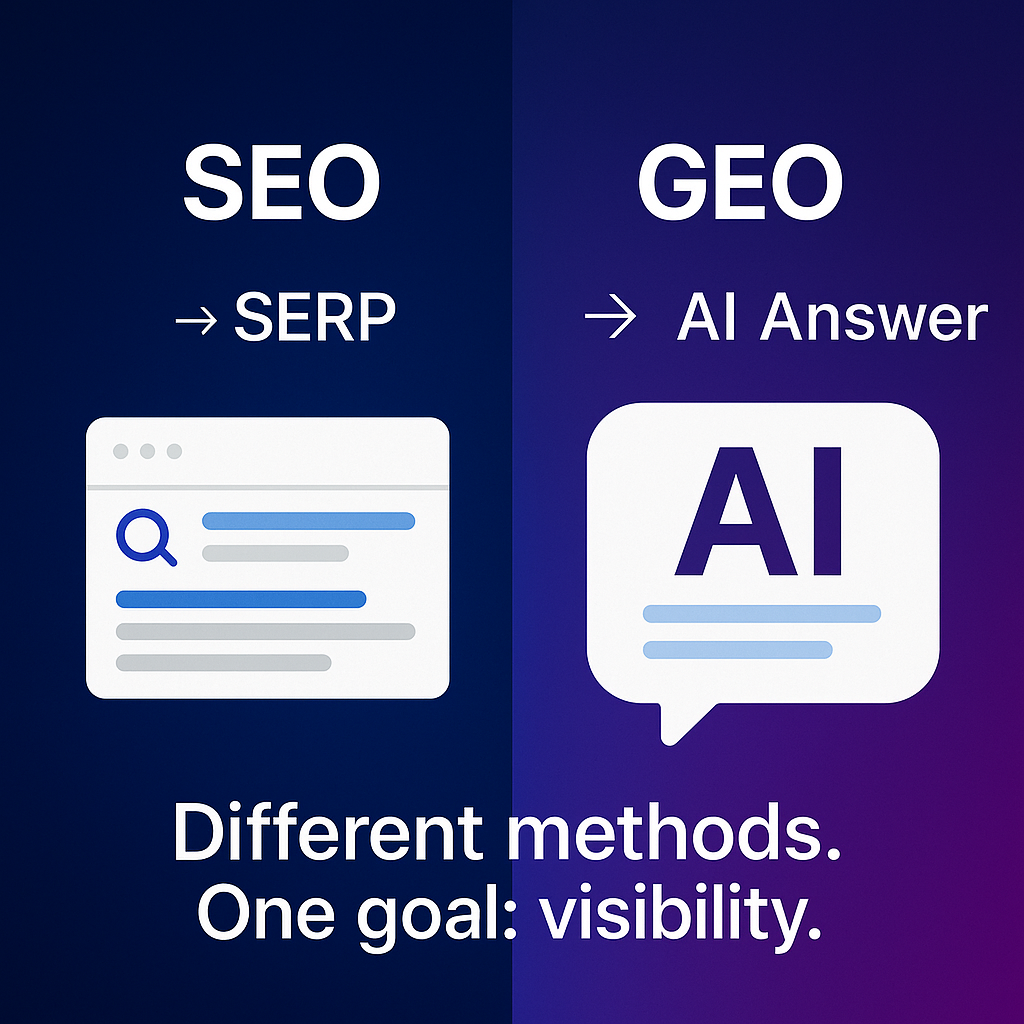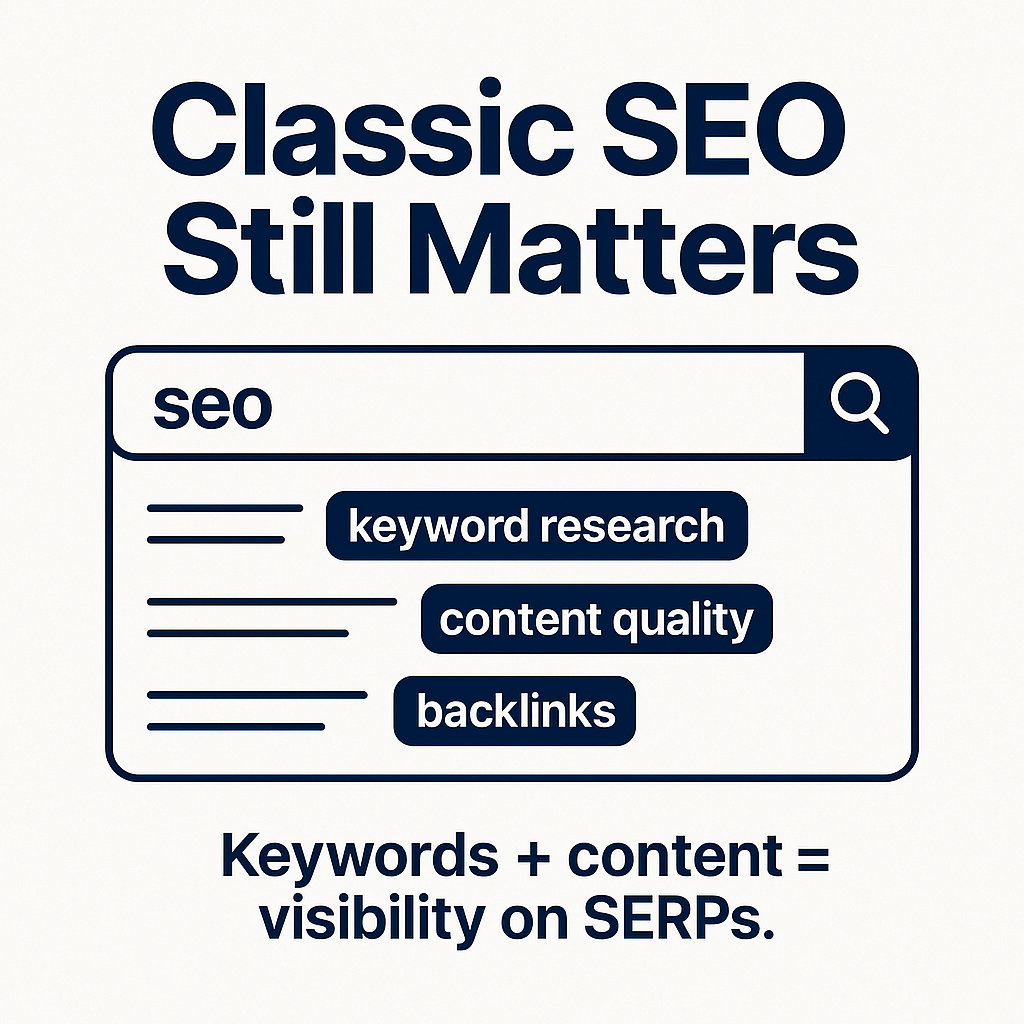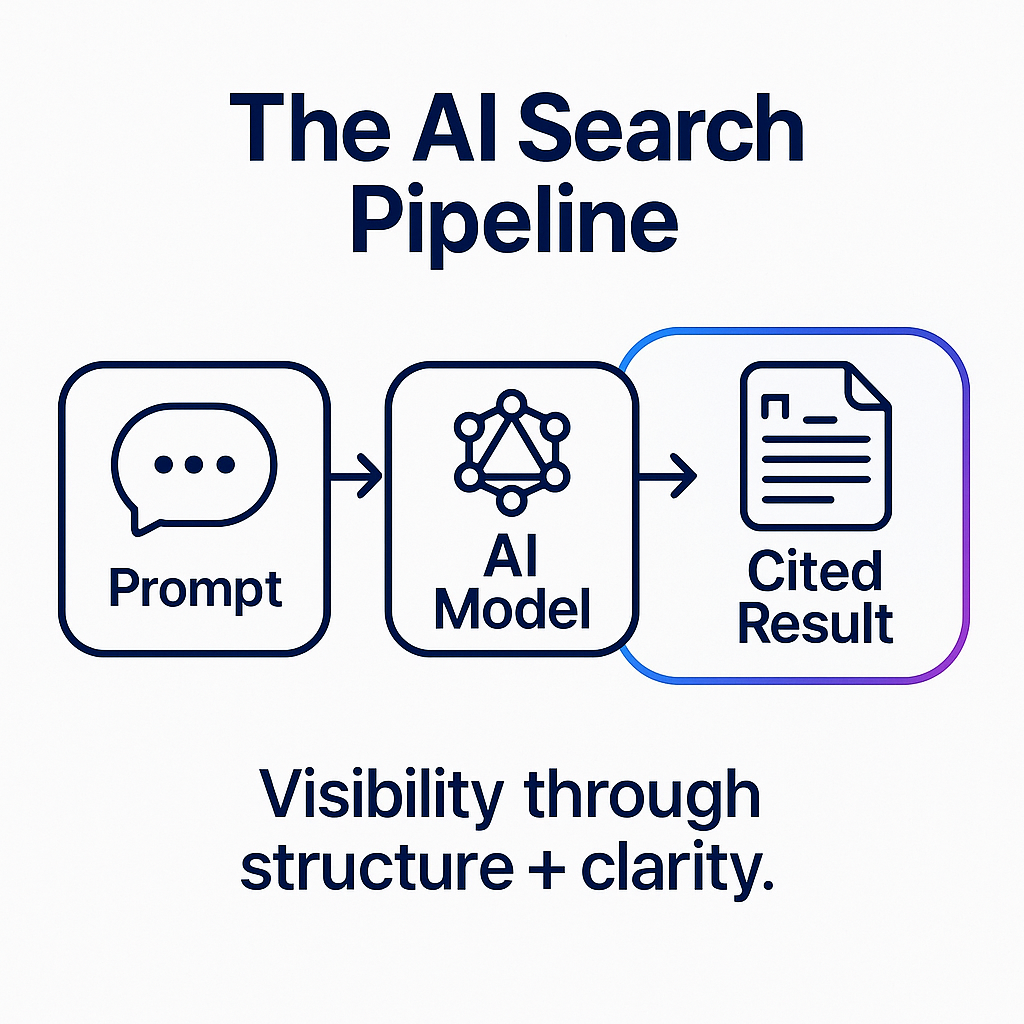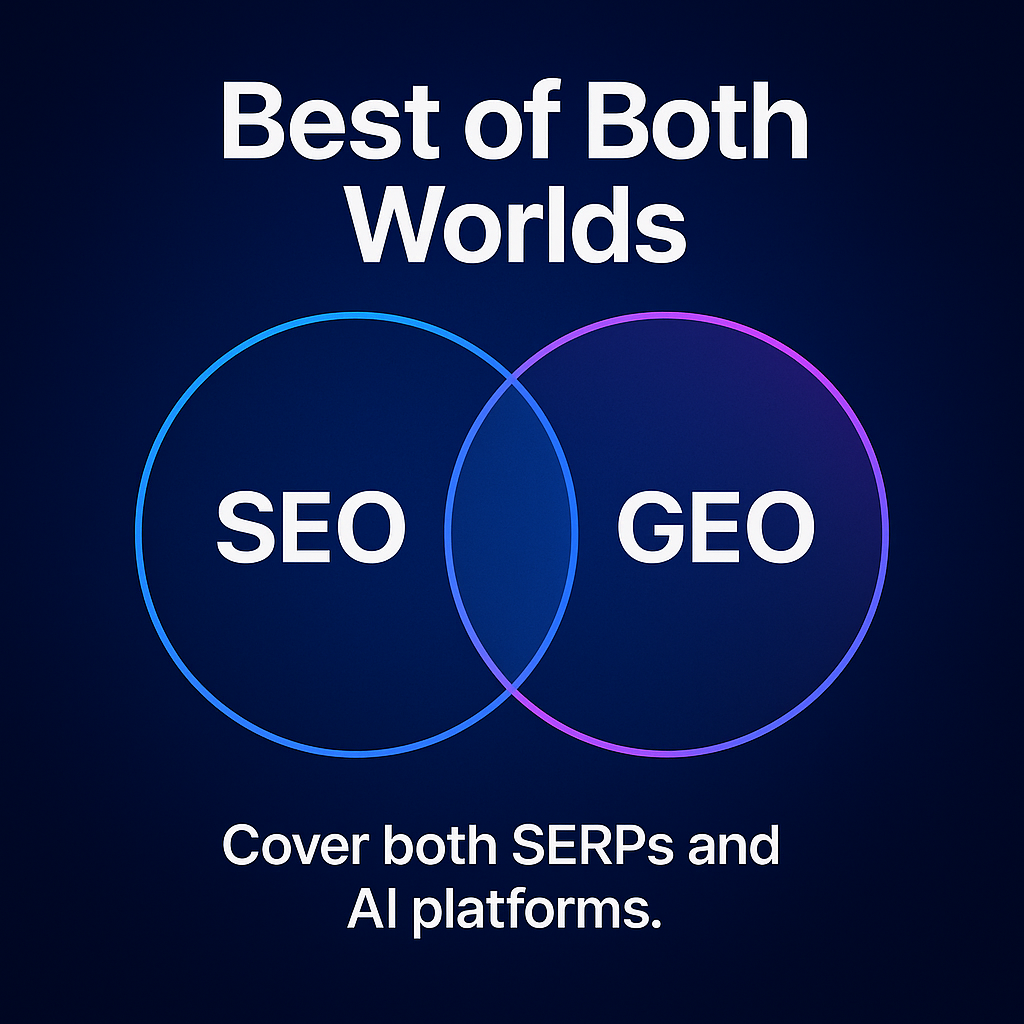
SEO Specialist
.jpg)
Confused about GEO vs SEO? You’re not alone. While SEO focuses on traditional search engines, GEO optimizes for AI-driven platforms. In this article, we’ll break down both strategies and show you how to use them to boost your digital marketing success.

SEO and GEO are the foundation of modern digital marketing strategies, each with its own approach and benefits. While traditional SEO optimizes content to improve your website’s visibility on search engine results pages, GEO optimizes content for AI-driven search engines like ChatGPT and Google AI Overviews. Both SEO and GEO aim to increase online visibility but do it in different ways and technologies.
As businesses try to get their target audience’s attention, understanding the difference between these two strategies can be a game changer. Traditional SEO practices like keyword research, content optimization and backlink building are still important, but combining GEO strategies can supercharge your digital marketing efforts.
SEO, or Search Engine Optimization, is the backbone of digital marketing that improves a website’s visibility on traditional search engines like Google and Bing. The goal of SEO is to improve a website’s ranking on search engine results pages (SERPs) by optimizing content to match search queries and improve user experience. Traditional SEO methods include keyword research, meta tags and creating high quality content that caters to user needs and search intent.
SEO is still important for driving organic traffic and website visibility. Traditional SEO helps businesses improve their search rankings, so their content can reach a wider audience. The focus is on creating content that is not only relevant but also authoritative so user engagement and satisfaction increases.
Generative Engine Optimization (GEO) is an advanced digital marketing strategy. It focuses on optimizing content for AI-driven search engines. Unlike traditional SEO which relies on manual keyword research and optimization, GEO targets AI-generated responses and optimizes for AI-powered search tools like ChatGPT and Google AI Overviews. The goal of GEO is to get your content in the synthesized responses of generative engines so visibility and engagement increases.
GEO strategies involves integrating structured data, relevant statistics and authoritative sources in your content. This way AI algorithms can easily understand and prioritize your content and make it more likely to be featured in AI-generated responses. Aligning your content with AI algorithms’ relevance criteria increases visibility and engagement on AI-driven platforms.

SEO works through a series of traditional SEO techniques to improve a website’s visibility on search engines. The process involves three main stages: keyword research, content creation and backlink building. The goal is to improve the important aspects of a website so user experience and search engine guidelines are met. Traditional SEO practices include:
White Hat SEO, which refers to ethical techniques to improve search engine rankings plays a big role in building online presence. Key techniques include:
This section will go deeper into each of these traditional SEO components.
Keyword research is the foundation of any successful SEO strategy. It involves identifying the terms and phrases your target audience uses when searching online. Thorough keyword research makes content more relevant and aligns it with user queries. Traditional SEO methods relies on manual keyword research to find relevant keywords that resonate with search engine users.
Optimizing content with these relevant keywords involves strategic placement in titles, headers and throughout the text including meta descriptions. This not only improves search engine rankings but also user engagement by providing optimized content that matches search intent. Focusing on natural language and user intent helps create high quality content that meets audience needs and increases online visibility.
Content quality is key in SEO as search engines rank high quality and relevant content. To achieve this content must be informative, engaging and tailored to address specific audience needs. The concept of e e a t (Expertise, Authoritativeness, and Trustworthiness) is important in SEO strategies as it ensures content is credible and authoritative so user trust and engagement increases.
Creating high quality content involves thorough research, using authoritative and credible sources and addressing user pain points with actionable insights. Optimizing content for user engagement and meeting E-A-T criteria improves website visibility and search engine rankings.
This approach not only improves SEO but also builds a strong online presence.
Backlinks is a key component of SEO, it’s an endorsement from one website to another. Quality backlinks from authoritative websites increases a site’s credibility in the eyes of search engines and boosts its ranking and visibility. Building a robust backlink profile improves search engine rankings and establishes authority in the industry.
The process of getting high quality backlinks involves creating valuable content such as a blog post that other websites want to link to. This can be done through guest blogging, partnerships and creating shareable content that provides value to other websites’ audience. Focus on quality over quantity builds a strong backlink profile and increases online visibility and authority.
Technical SEO is the foundation of all SEO efforts, it ensures a website is optimized for crawling and indexing by search engines. This involves:
Poor technical SEO can hinder even the best content from ranking well, that’s why it’s a critical part of any SEO strategy.
Key technical SEO strategies include:
Improving these technical aspects improves user experience and search engine rankings.
This comprehensive approach ensures all SEO efforts are backed by a solid technical foundation.

GEO is the next frontier in digital marketing, optimizing content for AI-driven search engines. Unlike traditional SEO which relies on manual methods, geo content uses AI technology to increase content visibility and engagement. The goal of GEO is to make geo different in how content appears in AI-generated responses, providing users with high quality and relevant information.
To achieve this, GEO strategies focus on information quality, contextual relevance and accessibility to AI systems. Integrating structured data and aligning content with AI algorithms’ relevance criteria increases visibility in generative AI outputs.
This section will go deeper into each of these GEO components.
Citations and statistics are key in GEO as they increase content trustworthiness and integrity. Adding authoritative references and relevant statistics makes content more likely to be featured in AI-generated responses. Embedding data points supports information integrity and makes your content more appealing to AI-driven search engines.
Establishing ongoing citation practices is important for content relevance and visibility. Implementing schema markup can further enhance how search engines interpret your content and improve its visibility in local search results.
Focusing on citation and statistical integration helps create data-driven content that meets AI algorithms’ needs and increases online visibility.
Contextual relevance and clarity is important for optimizing content for AI systems. The clarity of content structure directly impacts how well AI systems can interpret and prioritize the information. Using structured data helps AI systems to better understand and index your content and increase its ranking potential.
Content that matches user intent increases its chances of being surfaced by AI-driven platforms. Understanding how AI evaluates user behavior and trustworthiness is crucial for creating content that gets cited.
Focusing on contextual relevance and clarity helps create content that meets both users’ and AI algorithms’ needs and increases visibility and engagement.
Optimizing content for AI systems means creating content that is easily interpretable by AI engines. Generative AI engines create conversational and nuanced responses instead of just listing web pages, so it’s important to use structured data and AI-friendly content formats. Aligning content with AI algorithm preferences increases visibility in AI-generated responses.Metrics to measure success in GEO include impression metrics which measure visibility of citations and relevance. After gathering insights from GEO research, you need to align your content with AI algorithm preferences to optimize for AI-generated results. This comprehensive approach ensures your content is optimized for the AI-driven search engines landscape.
SEO and GEO share many common principles and practices but differ in their targets and methods. SEO aims to increase content visibility on traditional search engines, GEO optimizes for AI-driven platforms. Both are important for a comprehensive digital marketing approach, providing foundational web visibility and making content surface in AI-generated responses.
Understanding the unique and shared aspects of SEO and GEO can help businesses develop a better digital marketing strategy. By combining the strengths of both, businesses can increase online visibility and engagement and reach a wider audience across multiple platforms.
The main difference between SEO and GEO is in their targets and goals. SEO targets traditional search engines like Google and Bing, aims to improve website ranking on search engine results pages. GEO targets AI-driven search engines and aims to optimize content for AI-generated responses and voice search results.
GEO prioritizes featured snippets and direct answers, SEO focuses on improving search rankings through keyword optimization and content quality. By understanding these differences, businesses can tailor their digital marketing strategies to achieve specific goals and increase online visibility across different platforms.
Measuring success of SEO and GEO requires different metrics and tools. Traditional SEO uses metrics like click-through rate, bounce rate and time spent on page to gauge effectiveness. Tools like Google Analytics and SEMrush provide valuable insights into these metrics and help businesses refine their SEO strategies based on user engagement and click through rates.
GEO success is measured using different metrics, impression metrics that assess visibility of citations and relevance in AI-generated responses. Tools like HubSpot’s AI Search Grader can help businesses track performance and adjust their GEO strategies.
By understanding and adapting to these different metrics, businesses can maximize their digital marketing effectiveness and stay ahead of the curve.
Content creation is key for both SEO and GEO. For SEO, content must be informative, engaging and tailored to the audience’s needs, addressing their pain points and offering actionable insights. Traditional SEO practices involve thorough keyword research, optimization and strategic use of meta tags and descriptions to improve search engine rankings and user engagement.
GEO places even more emphasis on contextual relevance as AI engines require content that matches user intent. This means creating concise, question-based content that provides comprehensive answers that AI systems can easily interpret and prioritize.
By adding multimedia elements like infographics and videos, businesses can make their content more appealing and effective on AI-driven platforms. Combining these strategies ensures content is both engaging and optimized for maximum visibility across multiple search engines.

Integrating SEO and GEO can increase online visibility and engagement. Combining traditional SEO practices with advanced GEO techniques optimizes content for both traditional and AI-driven search engines. This integrated approach means better targeting, better alignment with user intent and overall better effectiveness.
Flexibility and creativity are key when adapting content strategies to emerging technologies. Using AI tools alongside expert SEO practices maximizes digital marketing impact.
This section will explore how SEO and GEO can work together and provide strategies for combining them.
Combining SEO and GEO means combining the strengths of both to increase online visibility and user engagement. Key points include:
One of the key strategies for optimizing content for AI extraction is to add clearer entity relationships and structure facts explicitly. GEO increases content visibility by building and maintaining brand authority and credibility.
Using both SEO and GEO provides an unbeatable user experience, discoverability and engagement across multiple platforms. Monitoring AI references to your content is also important to stay relevant and visible.
As AI search evolves, traditional SEO may not yield results. SEO professionals need to understand GEO to ensure content remains visible and relevant in an AI-driven digital landscape. Adapting to AI search means:
By staying ahead of AI search evolution, businesses can stay competitive and drive engagement and conversions. Understanding how AI engines generate responses and adjusting content accordingly means businesses will remain relevant and visible in a fast-changing digital landscape. This adaptability is key to maximizing digital marketing effectiveness.
GEO in digital marketing means:
GEO also future-proofs content strategies by preparing them for AI-driven search dynamics. By being adaptable and recognizing new opportunities, businesses can expand their reach and stay relevant in an AI-dominated digital world.
This section will explore the GEO benefits and how they contribute to a successful digital marketing strategy.
GEO optimizes content for AI-driven search engines, increasing visibility in AI-generated responses and voice search results. Implementing GEO can lead to massive visibility across AI-driven platforms, more visibility and user interaction. Effective GEO tactics include citing sources, adding quotes and statistics, all of which increase visibility in AI responses.
By focusing on these tactics, businesses can boost engagement and get their content featured in AI-generated responses. This visibility not only drives user interaction but also builds brand authority and credibility, overall better performance in digital marketing.
Future-proofing content strategies means adapting to emerging search technologies and being flexible with content creation. By experimenting and adapting, businesses can stay ahead of the curve and stay relevant in an AI-driven digital world. This means continuous learning and recognizing new opportunities as they arise.
Creating content that meets the needs of both users and AI algorithms is key to long-term success. By focusing on contextual relevance, user engagement and multimedia elements, businesses can keep their content competitive and effective in a fast-changing landscape.
This proactive approach to content strategy helps businesses future-proof their digital marketing.
Optimizing for GEO means combining AI with SEO to create content that meets AI-driven search engines. By using visual aids like infographics and charts, businesses can make data-driven content more impactful when presented to AI systems.This section will show you how to optimize for GEO so you can boost your online visibility and engagement.
AI-focused keyword research is key to aligning content with AI search behavior. Steps include:
Targeting keywords that match AI search behavior can increase visibility and engagement. By focusing on natural language and user intent, you can create high-quality content that meets your audience needs and boosts online visibility. This way content is not only relevant but also optimized for AI-powered search engines.
Structuring content for AI engines means creating content that is clear, organized and easily readable by AI systems. Using clear headings and question-based subheadings helps AI systems to extract and interpret content. By presenting content in a visually appealing way, you can make it more readable and appealing to AI algorithms.
Create concise, question-based content that AI systems can easily interpret and prioritize. This way content is optimized for AI-driven search engines, increases visibility and engagement. By focusing on content structure and clarity, you can create high-quality content that meets the needs of both users and AI algorithms.
Regularly checking GEO performance is crucial to refine strategies and stay visible in AI-generated responses. By continuously updating and refining GEO strategies based on research, you can keep your content relevant and competitive. Refreshing high-traffic pages encourages AI platforms to prioritize your content in search results.
Monitoring AI references to your content and making adjustments helps to stay relevant and visible. Focusing on continuous improvement and staying up-to-date with emerging trends maximizes GEO strategy and overall digital marketing performance.
In summary, mastering both SEO and GEO is key to staying ahead in the digital marketing game. By understanding the differences and similarities between these strategies, you can boost your online visibility and engagement across multiple platforms. SEO and GEO combined means content is optimized for both traditional and AI-driven search engines, a complete digital marketing approach. By being adaptable and recognizing new opportunities, you can future-proof your content and stay competitive. Go for SEO and GEO to unlock online visibility and drive your digital marketing.
The main difference is SEO is for traditional search engines like Google and GEO is for AI-driven search engines. Do both to maximize your online visibility!
GEO success is measured through impression metrics that track visibility and relevance of your citations. Use tools like HubSpot’s AI Search Grader to track your performance and impact.
Content quality is key for SEO because it increases user engagement and aligns with search intent, which improves your search engine rankings. Prioritize expert and trustworthy content to boost your online visibility!
GEO increases your visibility in AI-generated responses and user engagement. Go for these benefits to future-proof your content and stand out online!
Integrating SEO with GEO techniques increases your online visibility and engagement by optimizing content for both traditional and AI-driven search engines. Do both for maximum impact in your marketing!